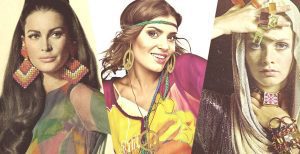The 1960s were a period of social and cultural upheaval, typified by an increasing sense of revolt against conventional culture. The hippie movement arose as a counterculture that rejected the prevailing culture’s principles in favor of a lifestyle centered on peace, love, and communal living. Hippies used fashion to show their rejection of traditional conventions, with vibrant and colorful 60’s Fashion Accessories that included aspects of nature and spirituality.
60’s Fashion Accessories were an important aspect of this fashion statement, and flower power in particular became an iconic emblem of the movement. Hippie accessories, from headbands to jewelry to purses and shoes, were distinguished by their use of natural materials, bright colors, and flowery designs. This article will explore the influence of hippie culture on 1960s fashion accessories, and how flower power came to represent the spirit of an era.

I. The Rise of Flower Power
In the late 1960s, the term “flower power” was coined as a symbol of the hippie movement’s emphasis on love and peace. Flowers were considered a natural and attractive manifestation of this feeling, and they rapidly became a staple of the hippie dress. The emergence of flower power can be linked to a greater societal change towards sustainability and anti-consumerism. The hippie dress was distinguished by its relaxed and casual look, in contrast to conventional fashion trends of the period, which emphasized formality and uniformity.
Clothing and 160’s fashion accessories were frequently constructed from natural materials like cotton, wool, and leather, with an emphasis on comfort and usefulness. Flowers in fashion were a natural extension of this mentality since they signified the beauty of nature and a rejection of artificiality. Floral motifs and patterns were utilized in everything from headbands to clothing to jewelry, resulting in a unified and recognizable aesthetic that came to symbolize the hippie lifestyle. Overall, the growth of flower power in 1960s fashion represented a larger societal shift towards a more holistic and ecological way of life, and it has endured as a symbol of the counterculture movement.
II. Headwear
Hippie dress relied heavily on headwear, which served both pragmatic and aesthetic purposes. Hippies favored a variety of headgear styles, including headbands, bandanas, floppy hats, and even turbans. These accessories were usually constructed of natural fabrics like cotton, hemp, and silk, with an emphasis on comfort and breathability in hot weather. Floral themes were very popular in hippie headgear, with flowers sometimes braided into headbands or utilized as ornamental embellishments on caps.
This represented the movement’s emphasis on the beauty of the natural environment, as well as the flower power movement’s ethos of peace and love. Headwear has influenced mainstream fashion trends, with hippie designs inspiring designers such as Halston and Yves Saint Laurent. Hippie headgear is still fashionable today, with headbands and floppy hats being popular 60’s fashion accessories. Overall, the centrality of headgear in 60’s fashion accessories reflects the movement’s emphasis on self-expression and individuality, as well as a rejection of conventional and restricted clothing norms.
III. Jewelry
Hippie dress relied heavily on jewelry as a way of self-expression and personal identification. Hippies preferred jewelry made of natural materials like wood, shells, and stones, with distinctive and odd patterns. The peace sign, which was extensively embraced as a symbol of the anti-art movement, was one of the most popular motifs. Flowers were a popular topic in hippie jewelry, with necklaces and bracelets embellished with colorful flower beads or embroidered with floral designs. Many hippies donned traditional tribal jewelry, such as African or Native American-inspired items, to connect with other cultures and show sympathy for marginalized groups.
In contrast to earlier generations’ formal and costly jewelry, hippie jewelry was frequently homemade and DIY, symbolizing the movement’s rejection of commercial culture and consumerism. Hippie jewelry continues to have an impact on the fashion world, with boho designs and natural materials remaining fashionable. Overall, the popularity of jewelry in 60’s fashion accessories represents the movement’s emphasis on self-expression and individuality, as well as a celebration of many cultures and a rejection of conventional conventions.
IV. Bags and Purses
Bags and purses were essential hippie fashion accessories, providing both utilitarian and aesthetic purposes. Hippies preferred large, capacious purses made of natural materials like leather, canvas, or crochet. The bags were frequently embellished with fringe, beads, and embroidery, reflecting the movement’s emphasis on handcrafted and do-it-yourself designs. flowery patterns were also used extensively, with flowery prints and embroidered flowers lending a splash of color and vitality to the bags. Hippies carried unorthodox bags such as backpacks, satchels, and even woven baskets in addition to regular purses.
Patches or pins with political or social statements were frequently affixed to these bags, expressing the movement’s activity and social conscience. Hippie bags continue to have an impact on the fashion industry, with boo-chic shapes and natural materials remaining trendy. Overall, the popularity of bags and purses in 60’s fashion accessories indicates the significance of practicality and comfort in daily life, as well as a rejection of traditional gender norms that governed women’s fashion choices.
V. Shoes
Hippie fashion relied heavily on footwear, which reflected the movement’s emphasis on comfort, practicality, and natural materials. Hippies used a variety of footwear, from basic sandals to moccasins, boots, and even bare feet. Many hippies preferred shoes made of natural materials such as leather, suede, and hemp, with an emphasis on durability and breathability in hot weather. Flowery patterns were also used extensively, with flowery prints and embroidered flowers bringing a splash of color and playfulness to the shoes.
Hippie shoes were frequently basic and utilitarian, in contrast to the formal and constraining footwear of prior eras, representing the movement’s rejection of consumer culture and consumerism. Hippie shoes continue to have an impact on the fashion industry, with bohemian designs and natural materials being fashionable. Overall, the prevalence of shoes in 60’s fashion accessories and hippie design indicates the significance of practicality and comfort in daily life, as well as a rejection of traditional gender norms that influenced women’s fashion choices.
VI. 60’s fashion accessories “Conclusion”
In conclusion, hippie culture had a profound influence on 60’s fashion accessories, particularly in the rise of flower power. Hippie fashion accessories were characterized by natural materials, DIY and handmade designs, and a celebration of self-expression and individuality. From headwear to jewelry, bags, shoes, and more, hippie accessories reflected the movement’s rejection of traditional norms and mainstream fashion trends.
The influence of hippie fashion can still be seen today, with bohemian and natural styles remaining popular in the fashion world. Overall, the flower power movement of the 1960s had a significant impact on the way we think about and wear fashion accessories, encouraging us to embrace our individuality, celebrate diversity, and prioritize comfort and practicality in our everyday lives.
